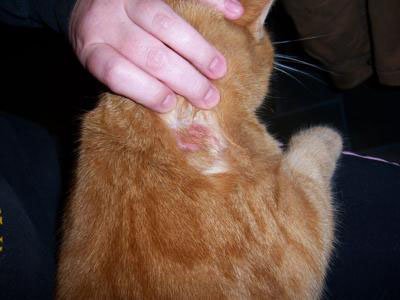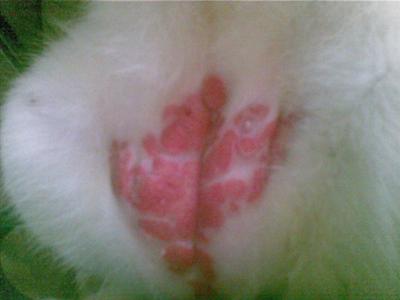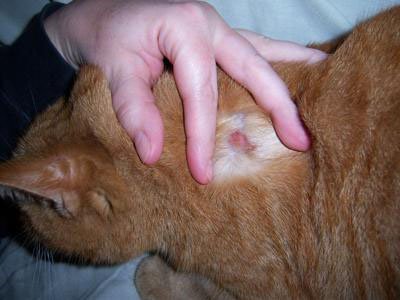Cat Skin Allergy or Neoplasia
by Iris
(Philipppines)
Cat Skin Problem Reader Question:
I have a male castrated cat. He is 2 1/2 years old now and the skin problem started last July 2009. It started as small wound at his side belly.
The vet prescribed antifungal and antibacterial creams. It didn't work. He is negative for mange and using Frontline spot on ever since we adopted him. Then they said that it is an autoimmune disease so they prescribed corticosteroid cream and injected him with steroid. The wound on his belly has no skin now and also around his anus. it is circular. There is a new one at his groin and it is bloody reddish shaped like the north american continent. It appears like a wheal.
The last that they prescribed was cefalexin and corticosteroid cream. Please help me. What is
the problem with my cat? is it treatable? What is the treatment?
Cat Skin Problem Editor Response:
Dear Iris;
Thank you for your question.
According to the appearance of the wheal like lesions, this condition appears to be a cat skin allergy, very similar to urticaria (cat skin hives). Such skin conditions are usually caused by different allergens, including chemicals, drugs, food components, bugs and even through exposure to sun light.
An acute or sudden form of this type of condition is easy to treat and usually resolves itself on its own, but chronic forms like the cat skin problem you describe in this case are not only very difficult to diagnose, they are also very difficult to treat.
As far as
Remember that chronic forms of this condition usually do not resolve itself, unless the underlying cause is removed.
In order to identify the exact cause, ask your veterinarian for a hypersensitivity test (allergy test) and consider all allergens as a possible cause of the condition. If the problem is related to any hypersensitivity of your pet, completely isolate your cat from this allergen during treatment and avoid any exposure in the environment.
An approved treatment for such cat skin allergy conditions are the use of anti-histaminic drugs along with corticosteroids. However, these should only be only be administered after confirmation of the specific cause of the condition.
Other therapeutics and products you are using for your cat including antibiotics and Frontline spot etc, should be reviewed. Most probably, these products can also act as a cat allergen at this stage.
In place of your cat's current shampoo, consider a natural product such as Stinky Paws Pet Wash.
Just in case the tests for hypersensitivity and an auto immune disease (allergy) come back negative, I suggest that you take your cat for a detailed biopsy, where a small skin sample will be tested. I fear, that this might be some kind of neoplasia (cat skin tumor) related to the immune system and skin.
Best of luck to you and your cat. Please keep us up to date on your cat's condition.
Click here to read or post comments
Join in and write your own page! It's easy to do. How? Simply click here to return to Cat Skin.
Cat Pulling Fur
by Lisa
(Winnipeg, MB, Canada)
Hi, my name is Lisa. I have a cat named Tess that is 17 years old, female, black domestic short haired and is having major skin problems right now.
It started around her eyes, which were inflamed, missing fur and constantly runny. For a while she could barely open her eyes or even look up, which is very unusual for her since she is so friendly and affectionate. This all stopped once her eyes started to look infected. We took her to the vet and they informed us that it could be a reaction to drywall (we were doing some renovations in our bathroom), so we gave her antibiotics and antihistamines. Unfortunately we were to administrate the medicine via oral pills. If you're an old cat set in your ways and who was never given pills before until now... you're in for a rough ride. We got the pills in her (much to her dislike) and she seemed to get better. After a while she seemed to be okay so we stopped with the pills, then the real problems began.
She began furiously licking and pulling her fur out. I noticed it around the inside of her legs and then it began to spread to her other legs, butt and chest. She would hide under my bed and wouldn't come out, wouldn't sleep and would barely eat. She would kick her legs repeatedly and it would keep me awake at night. We took her to the vet again and they gave her steroids and antibiotics, as well as a squeezing of her anal glands (which were very swollen). After that she would come out from under my bed and visit, eat, drink, use the litter box etc. Still, there seems to be no change in her skin. Actually, it looks worse. She continues to pull out her fur, leaving her legs patchy, pink and scabby, as well as her chest. She still comes out to eat and drink and all that but now she hides from us hours at a time. We don't know what more we can do for her and worry that this may be the end. Tess was rescued from a shelter when she was one and was a bit of a delinquent when we first got her but eventually she calmed down and turned into one of the most lovable cats out there. I love her dearly and I don't want to say goodbye even if she is 17.
We don't understand why she is in so much discomfort, if it's stress related from the initial pill popping, the renovations from months prior or if she's falling apart because she's so old. Like I mentioned she still eats and drinks and uses the litter box. Our last cat who died stopped all that altogether, though she had cancer and deteriorated far quicker. Tess has been having these issues for a month or so with no relief in sight. It's not skin cancer since she has no bumps, tumors and it's not like this is something she's dealt with before. If you have any information that could be helpful please write to me and let me know. Tess needs help ASAP.
I apologize for not having pictures. You must understand that I don't want any documents that show how bad she is, just in case she has to be put down and I'm left to deleting the pictures. I only want healthy pictures of her.
Thank you for understanding and for your help.
Lisa
Editor Suggestion - Cat Pulling Fur Out
Dear Lisa,
Sorry to hear about the cat skin problem.
Cat Skin conditions have various aspects, which can only be identified with a detailed clinical examination. The initial diagnostic approach includes identification of lesions and symptoms related to any particular condition.
In this particular case, taking a clinical history is important in making an initial diagnosis, i.e. the condition began with the problem around the eyes which turned in to a localized infection which then turned in to a generalized condition in the later stages.
This can possibly be a reaction to therapy administered for the eye condition, but most likely is an underlying immune mediated generalized problem. This can be anything related to a disturbed immune system. The worsening of this type of condition to such a level as you describe is related to age as a factor.
Older cats need more attention and care. A thorough diagnostic approach is needed for making a decision regarding this condition and a possible treatment plan for stopping the cat pulling fur problem.
I recommended that you take your cat for laboratory tests that can check for an immune system disturbance. Start with sensitivity tests and additional hypersensitivity tests (in vitro or intradermal). The level of circulating eosinophills should be carefully monitored and once the status of the immune system is revealed, a specific therapy can be initiated.
A Specific therapy for this type of condition typically involves the use of antibiotics, steroids, aurthioglucose (gold salts) and endocrinal restrictive agents. Usage of specific therapeutics are purely dependent upon the status of the immune system. Without this type of confirmation of the cat skin condition, it will certainly worsen over time.
Along with the specific therapy indicated by the tests and your veterinarian, it is recommended that your cat go for dietary elimination trials as well, to reduce the possibility that allergic responses in the body, triggered by different possible allergens in cat food, are causing the problem.
You can control symptoms such as chewing, licking and itchiness by using a cleansing herbal shampoo such as Clean Cat Shampoo and some type of remedy such as Allergy Itch Ease to reduce itchiness.
Additionally, to improve skin health and immune status, use a herbal tonic such as Skin and Coat Tonic. Be sure to pay more attention to your cat's medical conditions since she is a senior.
Please keep us updated on the cat pulling fur problem and best of luck to you and your cat.
Click here to read or post comments
Join in and write your own page! It's easy to do. How? Simply click here to return to Cat Skin.
Feline Skin Sore Licking
by Heather
(Pittsburgh, PA, USA)

Feline Skin Sore from Licking Shoulder
I adopted Faith a year and a half ago. At the time, she had a couple of spots on her that she had licked raw. I had hoped that she was only bored or frustrated at the shelter and would stop licking after she became comfortable in her new home.
Every couple of months or so I take her to the vet to get a Depo shot to help her heal, however, this doesn't always heal completely before the spots become raw and scabby again. Also, the shots can lead to kidney problems, and I don't want to have to deal with that again (I have treated a CRF cat before with sub-q's before).
I had a biopsy performed, which didn't resolve anything. The vet says she probably has an allergy but we don't know what to do.
Now, at first I didn't know that these spots were due to obsessive licking and have since learned that this is her behavior. I have also learned that she licks on her shoulders, both sides. When I first adopted her one or two of her spots were in other locations, but in the past year and a half these spots have only appeared on her shoulders. And I always see her licking.
I would really like to find an alternative to giving Faith steroid shots, which aren't always working anyhow. I would accept a cream or salve that would be safe for Faith to lick since I know she's going to lick it. It has to relieve her itch or pain, I just wish I knew what my poor girl was feeling.
Please help if you can. Thank you!
--Heather
Editor Suggestion Feline Skin Sore from Licking
Hi Heather,
Allergies are the most common reason for a cat to obsessively lick (other than fleas, perhaps), and the fact that Faith’s condition at least temporarily responds to the steroid injections makes this pretty likely in her case.
There are some microscopic external parasites that can cause similar symptoms, though. They can be pretty hard to diagnose, so if I have a patient like Faith, I’ll often just go ahead and treat for them. Three doses of Revolution (selamectin) 2 weeks apart will usually do the trick. Talk to your vet to see if he or she thinks this might be worth a try.
But, if allergies are the final diagnosis, I’m afraid topical medications are probably not going to help too much. As you mentioned, Faith will probably lick them off quickly and while this wouldn’t necessarily hurt her, it does mean that they won’t have a chance to do much good, either.
You could try an oral steroid like prednisolone, which would allow you to find the lowest, effective dose for Faith and reduce the possibility of side effects developing. Other medications (e.g., Atopica) are also available for treating allergies, but these are not free of side effects either.
Keep working at finding a solution for Faith. She must be super itchy and uncomfortable. Making an appointment with a veterinary dermatologist is always an option too.
Regards,
Jennifer Coates, DVM
Click here to read or post comments
Join in and write your own page! It's easy to do. How? Simply click here to return to Cat Skin.




